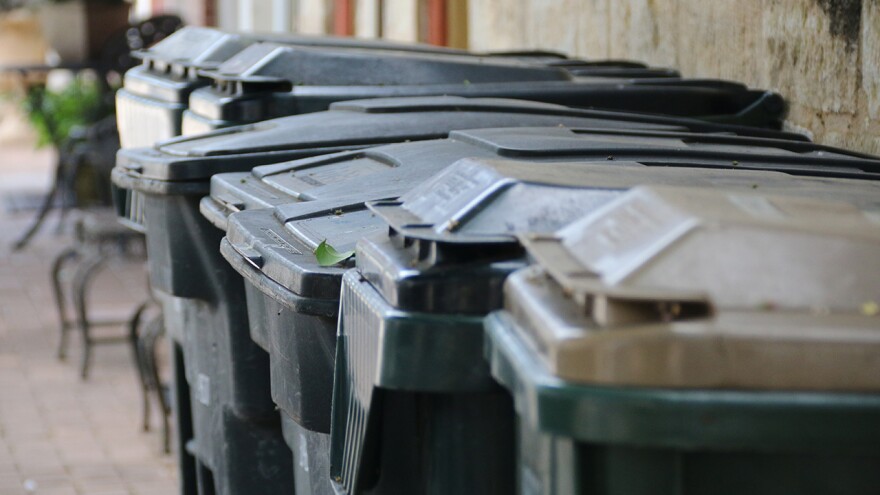ALLENTOWN, Pa. — Often, residents don’t know the true cost of litter in their neighborhood, Kyle Ropski said.
"And I think that that's often with environmental things — the cost of these impacts kind of get overshadowed,” Ropski, chairman of the city’s Environmental Advisory Council, said in a recent phone interview.
“I wholly believe that if we were to containerize trash being placed out of the curb, bagged and appropriately tied, placed in a container, out of the curb, we are going to significantly reduce litter almost instantly here in our city."Brett Stout, Allentown's manager of recycling and solid waste
“If your entire street is a lot cleaner, it's probably going to raise your property values, it's probably going to be cleaner outside.
"It's hard to illustrate the real cost and how simple solutions, such as containerization, could really uplift a community and uplift the neighborhood.”
As the EAC works with city officials to tackle litter, surveys and studies are helping to inform efforts, including a litter assessment completed over the summer by a pair of interns.
The assessment, obtained by LehighValleyNews.com through a Right to Know request, shows some of the problem areas for litter throughout the city, in addition to offering possible solutions, including containerization.
“I wholly believe that if we were to containerize trash being placed out of the curb, bagged and appropriately tied, placed in a container, out of the curb, we are going to significantly reduce litter almost instantly here in our city,” Brett Stout, city manager of recycling and solid waste, said.
‘Where litter is coming from’
The assessment was completed over the summer by two of the city’s Bureau of Recycling and Solid Waste interns, Terence “Terry” Dougherty and Dillon Fleckenstein, students at Millersville University and the University of Pittsburgh, respectively.
It was not produced or verified by city staff, officials said.
The purpose of the assessment was twofold, Stout said. In addition to fulfilling the requirements for the city’s Keep America Beautiful designation — the city this year received the President’s Circle Recognition Award — the effort also allowed city officials to get a fresh perspective.
“As far as litter is concerned, we have very good reasons to believe why there is litter in the city,” Stout said. “But are our interpretations accurate?
“This gives us a better gauge on trying to figure out ways in order to actually measure where the litter is coming from.”
There are three main parts of the study: mapping litter baskets, educating residents about yard waste pick-up and the litter assessment.
The litter assessment was conducted in July, during which Dougherty and Fleckenstein picked random streets in different areas of the city — the West End, Center City, Southside and East Side — to check for litter and record what they found.
They recorded and analyzed 305 instances of litter throughout the city, according to the assessment. The majority was found in Center City.
“I think in reviewing that data and that research, it was clear that the more people that you have, the denser the population, the more litter that you're going to get,” Ropski said.
“So I think we kind of knew that going in.”
Other findings
Other findings from the assessment include:
- Residents litter for convenience because of lack of trash cans
- Green spaces get the most attention during litter clean-ups
- And a large part of litter originates from businesses.
“Where I would push back on, and I did when they presented it to us, is more litter baskets doesn't solve the litter problem,” Stout said.
“It's behaviors on how people get rid of their trash, whether it's removing it from their vehicle or placing it out at the curb. Those are the two keys, I believe, in cleaning up a lot of litter that we have in our city.”
"Seeing this litter assessment done by city of Allentown interns throughout the entire city, and that they actually pointed to that as a long term solution was just another notch in the belt, in the sense of building the supporting data as to why containerization is necessary.”Kyle Ropski, chair of the Allentown EAC
Currently, city code shows “plastic bags may be used as municipal waste containers, at curbside for city curbside collection, provided they are sealed to prevent scattering of their contents and do not contain any rips, tears or punctures.”
“We kind of always have had this assumption that containerization is something that would be good,” Ropski said.
“And then, seeing this litter assessment done by city of Allentown interns throughout the entire city, and that they actually pointed to that as a long-term solution was just another notch in the belt, in the sense of building the supporting data as to why containerization is necessary.”
‘The single most important barrier’
This year already has brought changes — and increased cost to residents — for trash collecting services.
City Council in October of last year approved a new trash contract with J.P. Mascaro & Sons, which began June 1, costing the city $16.3 million for the first year.
Because of the new contract, property owners’ trash fees jumped from $415 to $605 this year. And that fee could hit $745 in 2026, with Mayor Matt Tuerk proposing a $140 increase in his budget.
It represents an almost-80% spike in just two years.
Requiring containers could add to that burden, and it’s one of the main obstacles, officials said.
“I'm simply open to explore any option to reduce the amount of litter here in our city, and if that means that we need to find ways to prevent litter from occurring at its source, being how people place out the trash, I believe that that's something that needs to be talked about.”Brett Stout, city manager of recycling and solid waste
“An ordinance change like containerization would, yes, there is going to be an additional cost or expense to the residents,” Stout said.
“And right now, yes, we have a proposed increase in our trash recycling fee. I'm understanding of that. I'm simply open to explore any option to reduce the amount of litter here in our city.
"And if that means that we need to find ways to prevent litter from occurring at its source, being how people place out the trash, I believe that that's something that needs to be talked about.”
Asked about strategies to cover the cost of containers, Ropski said “it’s tough.”
“We, as an advisory board, can point to potential solutions and we can provide suggestions,” he said.
“We've had suggestions of maybe having corporate partners come in. We know that there's potential grant opportunities that we could look to. There's been talks of pilot programs, maybe doing it on a smaller scale.
“I definitely think that [cost is] the single most important barrier to implementing this.”
New EAC website
Now the city, along the city EAC, is looking for residents’ opinions about containerization.
EAC members have worked on a survey for residents across the city to collect their opinions about it.
However, to make sure data from the survey is organized and collected in one space, the council has launched a website, allentowneac.org.
While Ropski described it as a “draft” with more work to be done, the website is live and includes information about the council, meeting materials and a calendar, as well as links to environmental initiatives in the city.
“We as a board want to make the survey effective, and to do that, we need to have a better home base, and this has been a long time coming — my white whale, per se,” Ropski said.
“And I decided I have to just lock in and get this website figured out so that we have the underlying infrastructure that we can give this survey a home base.
"That way people can easily access it, easily access our website, easily access all the other materials that we have.”
It’ll be at least the second citywide trash survey in recent years.
Another trash survey
Ahead of the new contract, city officials launched a survey to collect residents’ experiences with its trash and recycling services.
It found a majority of residents — 62% of respondents — expressed support for requiring trash to be both bagged and containerized.
“I don't want there to be any holes in it.”Kyle Ropski, chairman of Allentown’s Environmental Advisory Council
However, many of the respondents were from the 18104 ZIP code, the city’s West End neighborhood, an area with many single-family homes. Officials said that probably skewed results.
Those results compelled the EAC to work on creating another survey, focused on containerization.
Now, with the website well underway, members can return their attention to creating the survey. It’s expected to roll out early next year.
“We really want to do it right so that, at the end of the day, when we have this done, this is a very solid piece of evidence that we can point back to and infer as to why we want containerization and why containerization is good for the city and why we have community support behind it,” Ropski said.
“I don't want there to be any holes in it.”


